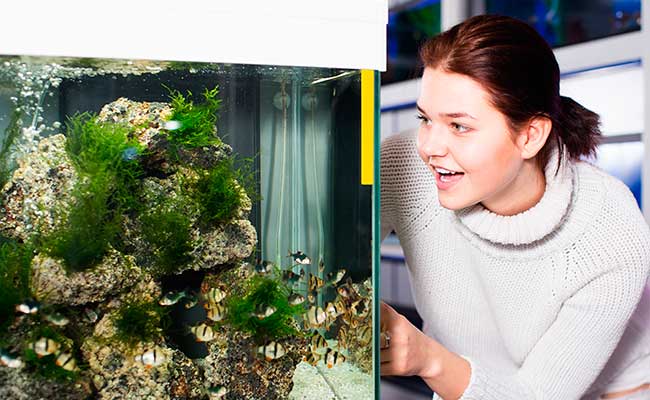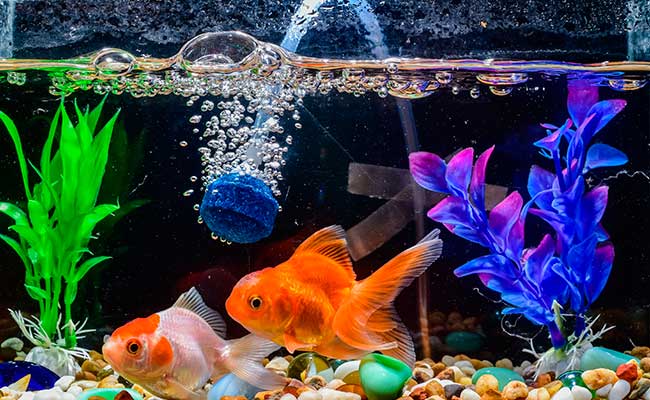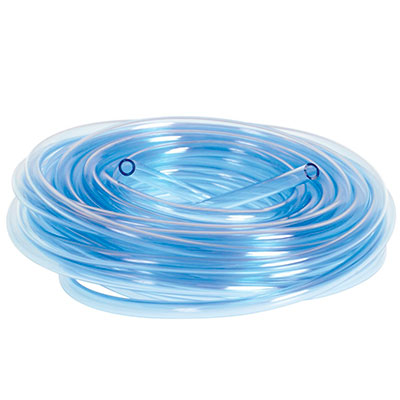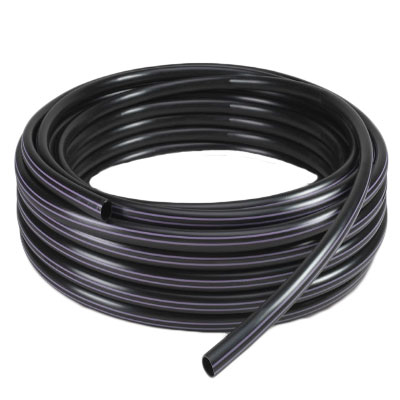While there is plenty of information to be found on air pumps and airstones, there isn’t a lot said about the very thing that connects the two…
I am talking about airline tubing.
You might be thinking:
It’s a tube…how much more do I need to know about it?
More than you think.
And today, I am going to teach you everything you need to know about it.
Contents
What is aquarium airline tubing?

You have likely seen it at fish stores: clear tubing that runs through the tanks…
Well, you were probably too distracted by the fish to see it, but it was definitely there!
That is airline tubing, and it has only one job…
To deliver air from your air pump to your aquarium.
Think of an airline tube as a train track. Air follows the tube until it reaches its destination.
The term airline refers to any flexible pipe that delivers air from your pump to your tank.
Airline tubing is commonly available in pet shops, fish stores or online. It is sold in rolls ranging from 8 to 50 feet in length – simply cut the amount that you need for your tank off the roll.
Beginners can also buy rolls of airline in a kit that also includes check valves and suction cup clips to keep the airline neat and tidy.
What size is airline tubing?

Unless you are going the DIY route, tubing for aquarium airlines comes in one standard size.
This is a good thing. It means that if you walk into any fish store and buy an aquarium airline tube, then you can expect it to fit your equipment.
The standard dimensions for aquarium air tubing are as follows:
| Measurement | Inner Diameter (ID) |
|---|---|
| Metric | 5mm |
| Imperial | 3/16 inch |
When an air fitting lists the size of tubing it will fit inside, it generally refers to the inner diameter (ID) of the tube.
The reason for this is that the outer diameter (OD) can vary according to the material that the airline tubing is made out of, especially for DIY projects. Rubber or silicon tubing, for instance, has thicker walls than plastic.
FishLab Tip: Some types of airline flex to accommodate larger fittings. For example, more flexible types of airline with an ID of 1/8 inch (3mm) can stretch over a 3/16 inch fitting just fine.
While aquarium airline tubes should be a standard size, I have seen cases where brand new tubing has been so loose that it falls off the air pump outlet. In these instances, it was generic tubing bought on eBay and shipped from overseas.
It is for this reason that I highly recommend buying from only reputable sellers.
Which is the best airline material – silicone or plastic?

I see the question come up time and time again:
Which is better airline tubing – silicone or plastic?
Well, the plastic they are talking about is typically vinyl, one of the most common materials used for aquarium airline tubing.
As for appearance, I’d say vinyl is the winner simply because it is available in more colors. However, some people are put off by the glossy surface that can shine under strong lighting.
Silicone, on the other hand, has a matte finish, which some find blends in better with their aquarium.
In terms of usability, I prefer silicone. It is much more flexible, bends easier and will straighten out under the weight of a sponge filter or airstone.
Vinyl is more difficult to shape and often kinks if you bend it the same way as silicone tubing. However, this can be overcome with the clever use of airline tubing connectors.
I would also add that new vinyl tubing has a strong plastic odor that is very unpleasant, but it soon goes away.
And finally, there’s aging…
Silicone is supposed to have the advantage in that it won’t harden and turn brittle like vinyl tubing.
Vinyl, however, becomes increasingly brittle and begins to crack as it ages.
So all in all, it looks like silicone is the winner, right?
I’ll be honest – my first two experiences with silicone were not great. I went with the cheapest option I could find, Top Fin and Penn Plax silicone tubing. At basically the same price as vinyl airline, how could I lose?
I can say that both of those tubings went brittle and cracked just like vinyl tubing.
While there is no arguing that the tubing was more flexible than the vinyl and would bounce back to its original shape, it just didn’t behave like silicone. And, it had that plastic-like smell.
Silicone is heat resistant and often used in coffee machines and home brewing because of this.[1]
So, I decided to run an experiment. I aimed my heat gun at the tubing, and it became soft and misshaped. Pure silicone does not act like that.
It appears that cheap aquarium silicone tubing uses some kind of hybrid vinyl/silicone mix – if anyone can clarify this I would love to hear the explanation. If that’s the case, I believe that it is disingenuous to put the words silicone airline tubing on the packaging.
Since then, I splurged on this medical-grade silicone tubing, and I can say that this stuff is the real deal! It is incredibly flexible, easy to work with and high quality. While it’s too early for validation, it’s been sitting in my tank for a year now without any issues.
Don’t get me wrong. I am 100% convinced I could find a happy medium between the cheap crappy “silicon tubing” and the high-end medical grade stuff – but after two bad experiences I thought I would go all out.
If you have any suggestions for a high-quality yet affordable silicone tubing, I would love to hear about them!
I have noticed a trend where many of the cheaper airline brands do not mention what material their tubing is made of. If this is the case, expect that it will be made from vinyl.
Whether you choose vinyl or silicone, both are more than capable of delivering air into your aquarium. But if you need tubing that is easy to work with, I recommend spending a bit extra and going the silicone route.
Which is the best airline tubing?
If you buy from your local pet store, then you will use whatever brand of tubing they keep on the shelves.
But if you buy online, you have many more choices.
Let’s take a closer look at some of the best airline tubing available for aquariums…
Best clear plastic airline
From the same company that created the incredible Python water changer, their plastic tubing is good quality and affordable. This is what I used prior to making the switch to silicone – no complaints.
Best black plastic airline – Lee’s
If you have a dark-colored background on your aquarium, you might find that black tubing blends in better than clear tubing.
At the end of the day, it comes down to preference – in all other areas, this airline performs identically to my previous pick. But if black is what you want, then Lee’s Sleek Black Tubing is as good as it gets.
Best silicone airline
While I love my current medical-grade silicone tubing, I still feel that it’s more expensive than what most people need. As such, I am in the process of tracking down a silicone airline that is not only high-quality but also offers the best value for the money. This spot will be updated shortly!
When do you replace your airline?
It’s unavoidable…
With continued use, your airline will eventually begin to show its age.
This is particularly true of vinyl airlines.
Fortunately, your air tubing will give pretty strong clues that it’s time to swap it out.
Here are some signs to look for:
1. Discoloration: The length of clear tubing will turn a yellow or brown color. This will be particularly noticeable at the pump outlet and joints in the tubing. Don’t confuse this with calcium buildup – if you can scratch it off, it’s calcium buildup.
2. Stiffness: The tubing will begin to feel hard and lose its flexibility, especially at joints.
3. Flakes: The airline will show faint cracks on the surface or flakes of the tubing will begin to fall off.
If the plastic tubing turns hard and brittle, it can crack at the joints or fall off the pump outlet completely.
If you notice any of these warning signs, it’s probably time to replace your airline.
Keep in mind that this process often takes years. But even so, I recommend occasionally checking to see how the tubing is holding up – you don’t want the airline to crack and leak while you are not home!
Aquarium airline is so cheap that it won’t hurt to keep an extra roll on hand, just in case.
FAQs on Aquarium Tubing
While I’ve pretty much told you everything I know about aquarium airline tubing that I’m sure would help you, I figured you might still have a few questions. So here are some frequently asked questions about aquarium tubing that might’ve popped up in your mind while reading.
Can I use airline tubing for water changes or siphoning in my aquarium?
Let’s nip this in the bud once and for all; you can’t use airline tubing for siphoning or water changes. Trust me, I’ve tried! Airline tubing is specialized for air delivery, not water. If you’re looking to swap out your water, a hose or an aquarium siphon is what you need.
Can I use any tubing with my air pump?
The short answer? No. I’ve made the mistake of being lax about this before, and it’s not something you want to repeat. Always check the manufacturer’s guidelines to make sure the airline tubing diameter is compatible with your air pump.
What is the ideal tubing size for large aquariums?
For those of you running a veritable ocean in your living room, you may need to look at aquarium tubing sizes that are a bit larger—like 6.4mm (1/4 inch) or 9.5mm (3/8 inch). This ensures that you’re getting enough O2 throughout your expansive underwater realm.
Can I cut aquarium airline tubing to the desired length?
Absolutely, and I always do. Grab a pair of scissors or a tubing cutter to snip your aquarium air line to the perfect length for your setup.
Are there special considerations for saltwater aquariums when choosing tubing?
Saltwater enthusiasts, listen up! I learned the hard way that you’ll need corrosion-resistant materials, like silicone or polyurethane, to stand up to the salt. Don’t skimp on this; always double-check for compatibility with your saltwater setup.
Final Thoughts on Aquarium Airline Tubing
You see, the aquarium airline tubing size mm and material you choose aren’t trivial matters—they’re crucial for the well-being of your aquatic family. It might seem like a tiny detail, but the best aquarium airline tubing can profoundly impact the vitality of your underwater ecosystem.
So, whether you’re tending to a cozy freshwater habitat or a sprawling marine reef, your choice in airline tubing could make or break your aquarium experience. It’s all about the details, my friends. And I’ve got to tell you, after years in this hobby, overlooking something as simple as tubing can throw your entire tank off balance.
If you really want your underwater kingdom to flourish, put in the effort to find the best aquarium airline tubing that’s just right for you. I promise, your diligence will be rewarded with a vibrant, healthy aquatic world right in the comfort of your home.
Do you use airline tubing in your aquarium? Let me know in the comments below!

Ian Sterling, founder of Fishlab.com, began his aquarium journey over 30 years ago, driven by a deep fascination for fish and their diverse personalities. His website, Fishlab.com, is dedicated to making fishkeeping accessible and enjoyable, offering beginner-friendly guidance, expert insights, and a community for aquarists to connect and share experiences.





Comments (7)
Regarding unwanted bacteria, how often should you change the tubing? How much unwanted bacteria builds up in the tubing?
Hi Irving,
Most hobbyists only replace their airline tubing when it becomes brittle, cracks or leaks – you know, things that would reduce air flow. I don’t consider the bacteria that builds up in an airline to be an issue, assuming air is constantly flowing through it.
Have you had experience with the cobalt silicone tubing?
Hi Bryan
Yes actually, I used a roll in my aquarium air pump review. It’s incredibly flexible and difficult to kink. I would happily use it on my own tanks.
Hi Ian,
Thanks for your great reviews! I use Pietypet black standard airline tubing (https://www.amazon.com/gp/product/B07DD8RJX) in my aquarium room. It is incredibly soft and flexible and I have yet to have a length fail (1+ years). It comes with useful suction cups, check valves, fittings, etc. in the linked package, but I have also today contacted the seller to inquire about buying in bulk without the accessories.
I don’t know if you’ve tried or even heard of this tubing (I had not before seeing on Amazon), but it is now a mainstay in my liquid life!
Warmly,
Kevin
Try US Plastics or McMaster-Carr as alt sources for good quality tubing, both pvc and silicone. They have many,many options so be prepared to do some research. McMaster calls one of their silicone tubing option high-temp rubber, fyi, helpful when searching. They are a touch more expensive than the mystery stuff on amazon.
Hi Eric,
Thanks for the advice, I’ll check them out!